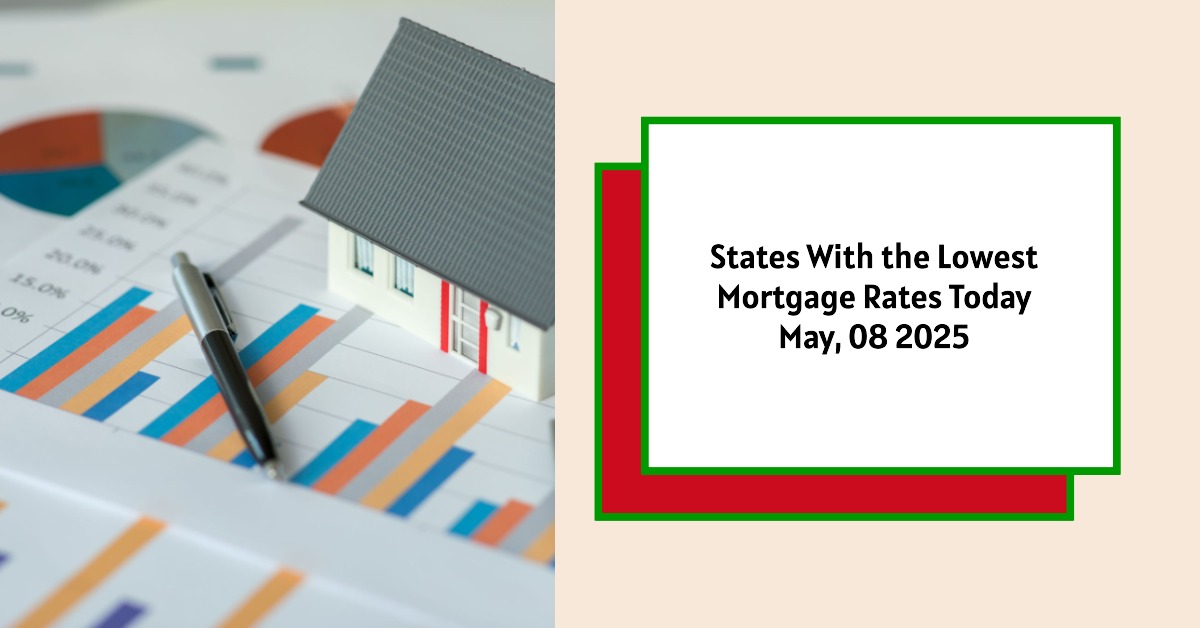As of today, May 08, 2025, homebuyers in some of the most populous states are finding a bit of relief, as New York, California, Florida, and Texas are currently showing the lowest 30-year new purchase mortgage rates. This is welcome news for a significant portion of the U.S. population, as these four states alone account for roughly one-third of all residents.
Following closely behind are Massachusetts, Oregon, and Pennsylvania, all registering average rates between a comfortable 6.71% and 6.88%. On the other end of the spectrum, states like Alaska, West Virginia, Washington D.C., and others are seeing averages climb towards the 7% mark.
Now, I know what you might be thinking: “Why does my neighbor in another state get a better rate than me?” It's a fair question, and the answer lies in a fascinating interplay of factors. You see, mortgage rates aren't just pulled out of thin air. They're influenced by a whole host of things that can vary quite a bit from state to state.
States With the Lowest Mortgage Rates Today – May 08, 2025
The State-by-State Story: What Makes Rates Differ?
Think of the U.S. mortgage market as a patchwork quilt, with each state having its own unique economic climate and lending landscape. Several key elements contribute to these state-level differences in mortgage rates:
- Competition Among Lenders: Just like any other business, mortgage lenders operate in specific regions. The level of competition between these lenders can significantly impact the rates they offer. In states with a higher number of active lenders, they might be more inclined to offer competitive rates to attract borrowers.
- Credit Score Averages: Believe it or not, the average credit score of residents in a particular state can play a role. Lenders assess risk based on creditworthiness, and a state with a generally higher average credit score might be seen as less risky overall, potentially leading to slightly lower average rates.
- Average Loan Size: The typical size of a mortgage loan in a state can also influence rates. This might be tied to the cost of housing in that area. Larger average loan sizes could sometimes lead to slightly different rate structures.
- State-Specific Regulations: Each state has its own set of regulations governing the mortgage industry. These regulations can affect lending practices, fees, and ultimately, the rates offered to borrowers.
- Lender Risk Management Strategies: Different lenders have their own ways of managing risk. Some might be more conservative in their approach, which could translate to slightly higher rates, while others might have a greater appetite for risk, potentially offering more competitive rates.
It's important to remember that the rates I'm talking about here are averages. The actual rate you'll qualify for will depend heavily on your individual financial situation, particularly your credit score, income, debt-to-income ratio, and the size of your down payment.
National Trends: A Broader Look at Mortgage Rates
While it's interesting to see the state-by-state breakdown, zooming out to the national level gives us a wider perspective. Following a brief uptick, the national average for a 30-year new purchase mortgage currently stands at 6.91% as of Wednesday. This is actually an improvement from mid-April when we saw rates jump to 7.14%, the highest point since May of last year.
Looking back further, we saw a more favorable period in March of this year when 30-year rates dipped to their lowest average of 2025 at 6.50%. And even more encouragingly, September of the previous year saw a two-year low of 5.89%. These fluctuations highlight just how dynamic the mortgage market can be, influenced by a complex web of economic factors.
To give you a clearer picture, here's a quick rundown of the national averages for different types of mortgages:
| Loan Type | New Purchase Rate |
|---|---|
| 30-Year Fixed | 6.91% |
| FHA 30-Year Fixed | 7.37% |
| 15-Year Fixed | 5.97% |
| Jumbo 30-Year Fixed | 6.88% |
| 5/6 ARM | 7.23% |
Source: Zillow
Decoding the Drivers: What Makes Rates Go Up and Down?
Understanding why mortgage rates move the way they do can feel like trying to predict the weather, but there are some key underlying factors at play:
- The Bond Market (Especially 10-Year Treasury Yields): This is a big one. Mortgage rates tend to closely follow the trends in the bond market, particularly the yield on 10-year Treasury notes. When investors perceive higher risk or inflation, Treasury yields tend to rise, and mortgage rates often follow suit. Conversely, when there's economic uncertainty and investors flock to the safety of Treasury bonds, yields can fall, potentially pulling mortgage rates down with them.
- The Federal Reserve's Monetary Policy: The actions of the Federal Reserve, our central bank, have a significant, though sometimes indirect, impact. The Fed's policies, such as buying or selling government bonds and setting the federal funds rate, can influence the broader economic environment and the availability of credit, ultimately affecting mortgage rates. For example, during the pandemic, the Fed's bond-buying program helped keep mortgage rates relatively low. However, as they began to taper these purchases and raise the federal funds rate to combat inflation, we saw a corresponding increase in mortgage rates.
- Competition Among Lenders: As I mentioned earlier, the level of competition in the mortgage industry plays a crucial role. When lenders are vying for borrowers, they might offer more attractive rates and terms.
- Overall Economic Conditions: Factors like inflation, unemployment rates, and economic growth can all influence the direction of mortgage rates. A strong economy might lead to higher rates as demand for borrowing increases, while a weaker economy could result in lower rates to stimulate borrowing and investment.
It's a complex dance of these factors, often happening simultaneously, which makes it challenging to pinpoint a single cause for any specific rate change.
Read More:
States With the Lowest Mortgage Rates on May 7, 2025
Projected Mortgage Rates for the Week of May 5-11, 2025
When Will Mortgage Rates Go Down from Current Highs in 2025?
The Golden Rule: Shop Around, Shop Around, Shop Around!
Regardless of which state you're in or the current national trends, there's one piece of advice I always give to anyone looking for a mortgage: shop around! Rates can vary significantly from one lender to another, even for borrowers with similar financial profiles.
Don't just settle for the first quote you receive. Take the time to compare offers from multiple banks, credit unions, and online lenders. A little bit of comparison shopping can potentially save you thousands of dollars over the life of your loan.
Keep in mind that advertised “teaser rates” might not reflect the actual rate you'll qualify for. These rates often come with strings attached, such as needing to pay points upfront or having an exceptionally high credit score. Focus on getting personalized quotes based on your specific circumstances.
My Two Cents: Navigating the Mortgage Maze
Having followed the housing and mortgage markets for quite some time, I've learned that patience and persistence are key. The ideal mortgage rate is out there, but you need to be proactive in finding it. Don't be afraid to ask lenders questions about their fees, terms, and any discounts you might be eligible for.
Also, remember that the mortgage rate is just one piece of the puzzle. Consider the total cost of the loan, including closing costs, taxes, and insurance. A slightly higher rate with lower fees might actually be a better deal in the long run.
While the current dip in rates in some populous states offers a glimmer of hope for many aspiring homeowners, the overall market remains sensitive to economic shifts. Staying informed about these trends and being prepared to act when the time is right is crucial.
In conclusion, while New York, California, Florida, and Texas currently boast the lowest average 30-year new purchase mortgage rates as of May 08, 2025, the mortgage landscape is dynamic and varies significantly by state due to factors like lender competition, credit score averages, loan sizes, and state regulations.
Nationally, after a recent climb, the average 30-year fixed rate has settled at 6.91%. Remember that individual rates will vary based on your financial profile, and it's always essential to shop around and compare offers from multiple lenders to secure the best possible terms.
Work With Norada, Your Trusted Source for
Real Estate Investment in the U.S.
Investing in turnkey real estate can help you secure consistent returns with fluctuating mortgage rates.
Expand your portfolio confidently, even in a shifting interest rate environment.
Speak with our expert investment counselors (No Obligation):
(800) 611-3060
Also Read:
- Will Mortgage Rates Go Down in 2025: Morgan Stanley's Forecast
- Expect High Mortgage Rates Until 2026: Fannie Mae's 2-Year Forecast
- Mortgage Rate Predictions 2025 from 4 Leading Housing Experts
- Mortgage Rates Forecast for the Next 3 Years: 2025 to 2027
- 30-Year Mortgage Rate Forecast for the Next 5 Years
- 15-Year Mortgage Rate Forecast for the Next 5 Years
- Why Are Mortgage Rates Going Up in 2025: Will Rates Drop?
- Why Are Mortgage Rates So High and Predictions for 2025
- Will Mortgage Rates Ever Be 3% Again in the Future?
- Mortgage Rates Predictions for Next 2 Years
- Mortgage Rate Predictions for Next 5 Years
- Mortgage Rate Predictions: Why 2% and 3% Rates are Out of Reach
- How Lower Mortgage Rates Can Save You Thousands?
- How to Get a Low Mortgage Interest Rate?
- Will Mortgage Rates Ever Be 4% Again?



